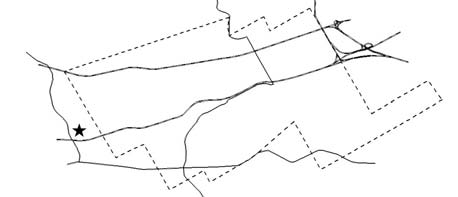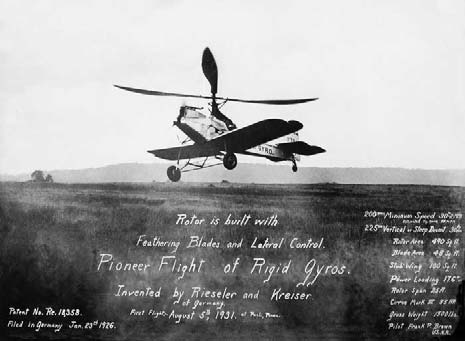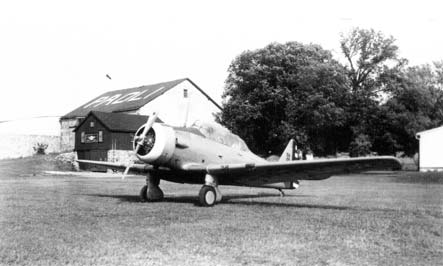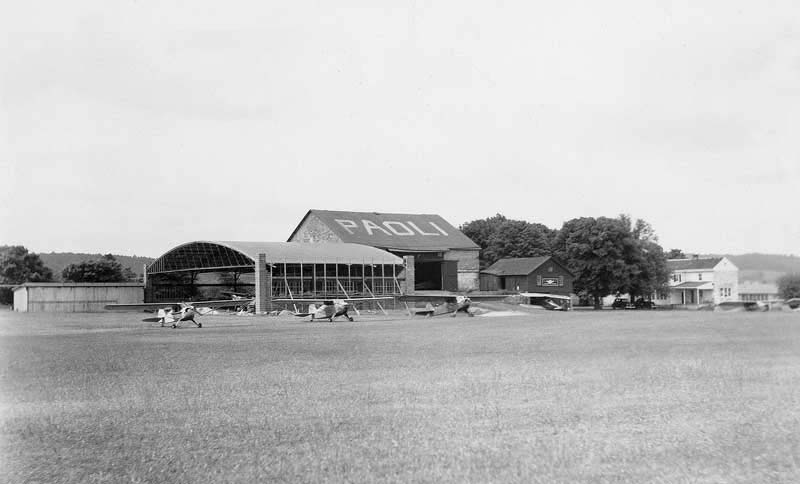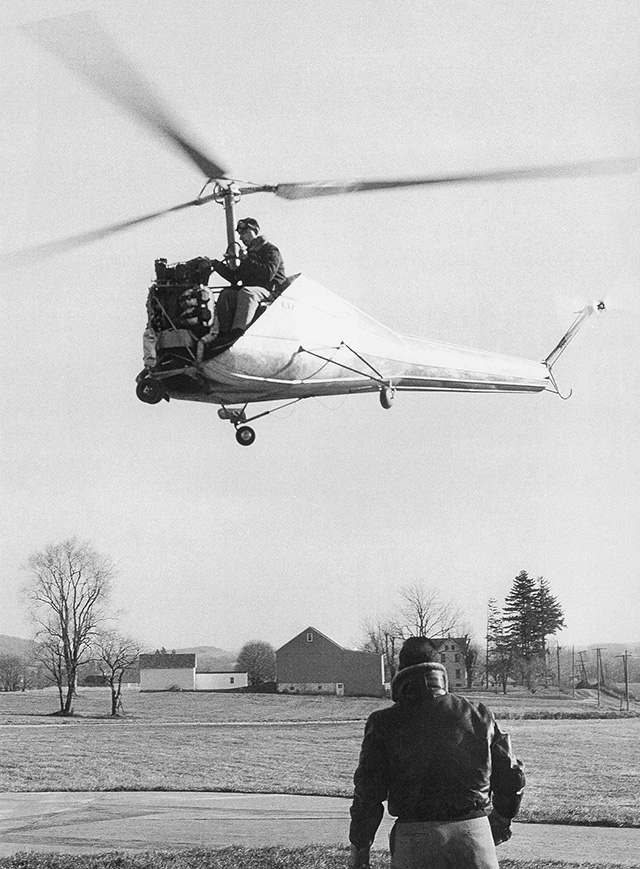|
Home : Quarterly Archives : Volume 44 |
Tredyffrin Easttown Historical Society |
|
Source: Winter/Spring 2007 Volume 44 Numbers 1&2, Pages 62–64 The Main Line Airport
The history of the Main Line Airport starts in the 1920s with Charlie Devaney, who purchased a surplus World War I aircraft in kit form, assembled it, and taught himself to fly using a field in his father's farm for take-offs and landings. In 1929 the inventor E. Burke Wilford purchased the farm from William Devaney, Charlie's father. He used the name the Philadelphia Main Line Airport Company and had the name PAOLI painted on the barn roof as a guide to pilots. Wilford had developed an autogyro, a helicopter predecessor. In 1931 aviation history was made with the autogyro's first successful flight. With interest in the aircraft growing Wilford relocated to the Mills Seaplane Base in Essington.
First flight of Autogyro #2, 1931 During the time of Wilford's occupancy, fixed wing flying continued and the facility became known as the Paoli Airport. Even in the depression years interest in aviation continued to grow. On weekends especially, spectators would drive from far and near to the airport to watch and participate in the excitement. Passengers would buy short flights in open cockpit bi-planes; student fliers would take training flights with one of the instructors operating at the airport; and the owners of a growing number of private airplanes added flying hours to their log books. The purchase of an additional tract of land directly east of the original Devaney property substantially lengthened the runways. In the summer of 1934 the American Legion Air Circus was held at the airport. Thousands of spectators came to Paoli to watch well-known pilots compete for prizes as they raced their planes around the pylons. Observers described having never heard such a tremendous roar of engines as the competitors flashed by the crowds. In 1936, Demorr Aeronautical Corporation was formed by Charlie Devaney and his friend Nicholas Morris. Demorr (a contraction of Devaney and Morris) set out to become an airplane sales and service organization of prominence on the east coast. Using the Main Line Airport as their base, Demorr succeeded in achieving their dream by becoming the area distributor for Ryan Aeronautical (manufacturer of Lindbergh's Spirit of St. Louis, and later the Ryan ST and the SC monoplanes). Demoor would later hold the Philadelphia area distributorship for Piper Aircraft of Lockhaven, PA. The War Years In the spring of 1940, the Main Line Airport became the beneficiary of a government program designed to train pilots in the eventuality of war. The Civilian Pilot Training Program (CPTP) was designed to admit 18 to 27 year olds, primarily college students, already pre-screened to successfully pass the rigid Air Corps flight physical, and qualify them at government expense to obtain a private pilot license. If war came, these pilots would be inducted directly into the military service. Instructors trained between 50 and 75 young pilots at the Main Line Airport during the next three years.
BT-9 Trainer at the Main Line Airport Within weeks of the outbreak of war a Civil Air Patrol squadron was established at the Paoli Airport, and 15 to 20 local men stepped forward to offer their services as volunteer pilots and mechanics. Pilots would provide their own airplanes and equipment in return for a government subsidy. The CAP insignia began appearing on private aircraft at the airport. Some members of the Paoli Squadron even served as pilots with Coastal Patrol squadrons along the Mid-Atlantic coast hunting for German U-boats during 1942-3. The airport never completely closed to aviation during the war, and many military aircraft flown by Naval aviators from Mustin Field at the Philadelphia Naval Yard came to visit. The Great Valley was apparently considered an ideal training locale, for many accounts and photos exist of loud and powerful Navy fighters roaring down the Valley and over the airport with their engines screaming, scaring livestock and agitating even the most patriotic neighbor. On many occasions these aircraft briefly landed at the airport.
The Airport, summer 1940 The Post War Years The airport continued successfully after the war but in 1950 an attractive offer led to it being sold to Bethlehem Steel. Limestone, along with iron ore and coal, is a basic raw material for steel production. Borings had shown that the substrate beneath the airport property was high-grade limestone, and Bethlehem wanted this land for a limestone quarry. Bethlehem held the land in reserve and returned the area to grazing pastures.
The HK-1, 1957 Aircraft designer Haig Kurkjian had come to believe that light aircraft could be a natural extension of the family automobile. He prophesied that his prototype, which he called the HK-1 “ ... is the first step toward a ship that will be marketed in the Cadillac price range, a ship that will virtually eliminate the necessity for urbanization by making commutation and private transportation in general far faster and safer than automobile travel.” With his dream alive, Kurkjian was now looking for a permanent home for his company, Haig-K Aircraft. and leased part of the land from Bethlehem Steel for its operations. In 1957 the HK-1 made its maiden flight but Kurkjan was never able to raise enough capital to bring the aircraft into production. Between 1963 and 1973 the airport was used for helicopter repairs. The Final Chapter In June 1964, in order to raise additional cash resulting from brutal industrial competition, Bethlehem Steel Company sold its properties in the Chester Valley, including the old Main Line Airport, to a company in Wilmington, DE. In 1974, Liberty Property purchased the first 650 acres of what would become the Great Valley Corporate Center. By 1977, in order to generate desperately needed cash flow for his business, Haig Kurkjian had sub-let a portion of the 6,000 sq. ft. main hangar to an auto body and paint shop. A spray painter got careless, and flammable paint was ignited by a nearby acetylene torch. The inferno, fueled by gasoline from the many automobiles parked inside, quickly consumed the hangar and all the contents. The trauma to Haig-K Aircraft was terminal, and the firm abandoned the land in 1978. In that same year, a company called Shared Medical Systems (SMS), one of the first occupants of the Great Valley Corporate Center, broke ground for its large Data Center, with its Corporate Headquarters to follow two years later. Interestingly, the entrance to SMS (now Siemens) is almost precisely at the intersect of the fixed-wing runways of the old Main Line Airport. |
| Previous Article ⇐ ⇒ Next Article |
